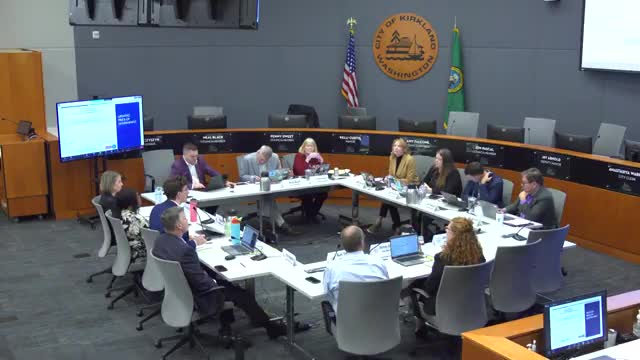Kirkland planners weigh larger stream buffers and a Riparian Management Zone; debate centers on nonconforming homes and speed of environmental gains
November 07, 2025 | Kirkland, King County, Washington
This article was created by AI summarizing key points discussed. AI makes mistakes, so for full details and context, please refer to the video of the full meeting. Please report any errors so we can fix them. Report an error »

Kirkland planning staff briefed the council on Nov. 5 about proposed updates to the city’s critical‑areas code—chiefly geologic hazards and stream/wetland protections—and presented the Planning Commission’s recommendation for a Riparian Management Zone (RMZ) approach rather than a simple uniform buffer expansion.
What staff presented: The code update revises Chapter 85 (geologic hazards) to add clearer exemptions for low‑risk repairs and to consolidate vegetation/tree management rules; it also proposes Chapter 90 revisions (streams and wetlands) that respond to best‑available science and tribal and state agency comments. The Washington Department of Fish and Wildlife and local tribes advised larger stream buffers and changes consistent with forestry‑based best practices.
RMZ versus straight buffer expansion: Planning staff laid out two primary approaches discussed by the Planning Commission:
- Straight buffer expansion: increase minimum buffers (planning staff cited 100 feet as a commonly recommended minimum). Doing so increases the number of properties covered by buffer rules and would create many additional legally nonconforming situations for existing homes; remediating or changing those properties would be constrained under the new buffer rules.
- Riparian Management Zone (Planning Commission preference): adopt a broader RMZ boundary (for example, 150 feet with a 133‑foot outer boundary in some mapping) that emphasizes tree retention, restoration planting, no interrupted buffers, and low‑impact development measures that generate measurable ecological improvements faster. The RMZ approach focuses on active restoration and tree canopy improvements and allows targeted requirements when redevelopment or large additions trigger code standards.
Tradeoffs and council concerns: Staff said a straight buffer increase would add about 1,000 additional properties to critical‑area regulation and could create significant nonconforming‑property impacts; by contrast, staff argued, the RMZ approach could produce measurable water‑quality and habitat improvements more quickly because it leans on tree canopy and urban forestry strategies that can be implemented in redevelopment or through proactive restoration programs. Council members raised fairness concerns (how the rules affect individual property owners), the potential hit to property owners’ ability to renovate or add features, and the risk of appeals to the Growth Management Hearings Board if the city’s approach departs from best available science. Staff said doing nothing is unlikely to be defensible given new best‑available science and agency input.
Next steps: Staff will return with ordinance language to implement the chosen approach and additional details on the rollout and mitigation for existing nonconforming properties. Council asked staff to provide clarifying materials that quantify how many homes would transition to nonconforming status under each option and to spell out specific exemptions and tree‑retention standards to reduce owner uncertainty.
Why it matters: Changes to buffer geometry and restoration requirements affect private property rights, redevelopment feasibility and the pace of environmental recovery for local streams and wetlands. The council must balance ecological objectives against impacts to homeowners and potential legal risk.
What staff presented: The code update revises Chapter 85 (geologic hazards) to add clearer exemptions for low‑risk repairs and to consolidate vegetation/tree management rules; it also proposes Chapter 90 revisions (streams and wetlands) that respond to best‑available science and tribal and state agency comments. The Washington Department of Fish and Wildlife and local tribes advised larger stream buffers and changes consistent with forestry‑based best practices.
RMZ versus straight buffer expansion: Planning staff laid out two primary approaches discussed by the Planning Commission:
- Straight buffer expansion: increase minimum buffers (planning staff cited 100 feet as a commonly recommended minimum). Doing so increases the number of properties covered by buffer rules and would create many additional legally nonconforming situations for existing homes; remediating or changing those properties would be constrained under the new buffer rules.
- Riparian Management Zone (Planning Commission preference): adopt a broader RMZ boundary (for example, 150 feet with a 133‑foot outer boundary in some mapping) that emphasizes tree retention, restoration planting, no interrupted buffers, and low‑impact development measures that generate measurable ecological improvements faster. The RMZ approach focuses on active restoration and tree canopy improvements and allows targeted requirements when redevelopment or large additions trigger code standards.
Tradeoffs and council concerns: Staff said a straight buffer increase would add about 1,000 additional properties to critical‑area regulation and could create significant nonconforming‑property impacts; by contrast, staff argued, the RMZ approach could produce measurable water‑quality and habitat improvements more quickly because it leans on tree canopy and urban forestry strategies that can be implemented in redevelopment or through proactive restoration programs. Council members raised fairness concerns (how the rules affect individual property owners), the potential hit to property owners’ ability to renovate or add features, and the risk of appeals to the Growth Management Hearings Board if the city’s approach departs from best available science. Staff said doing nothing is unlikely to be defensible given new best‑available science and agency input.
Next steps: Staff will return with ordinance language to implement the chosen approach and additional details on the rollout and mitigation for existing nonconforming properties. Council asked staff to provide clarifying materials that quantify how many homes would transition to nonconforming status under each option and to spell out specific exemptions and tree‑retention standards to reduce owner uncertainty.
Why it matters: Changes to buffer geometry and restoration requirements affect private property rights, redevelopment feasibility and the pace of environmental recovery for local streams and wetlands. The council must balance ecological objectives against impacts to homeowners and potential legal risk.
View full meeting
This article is based on a recent meeting—watch the full video and explore the complete transcript for deeper insights into the discussion.
View full meeting
